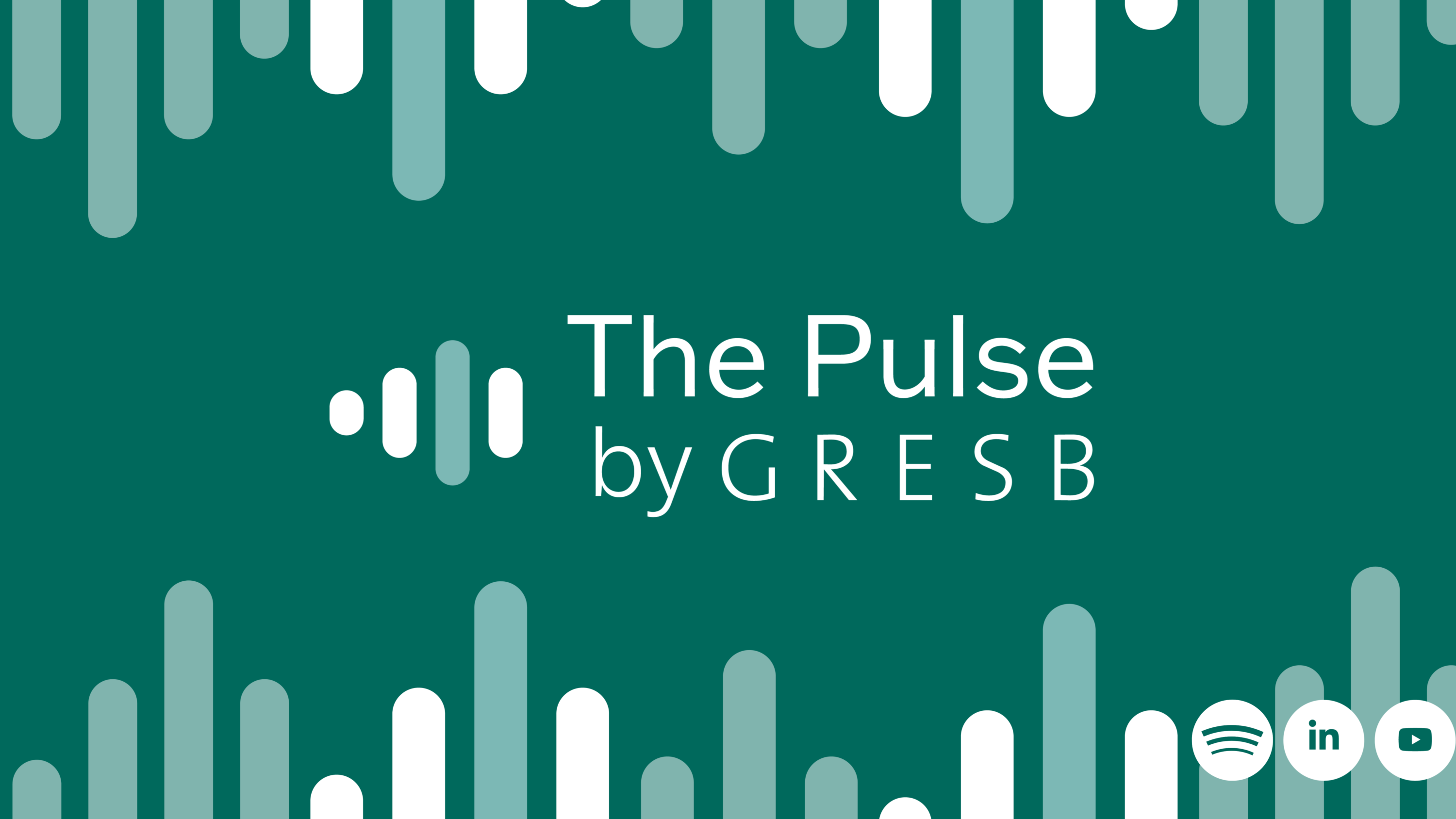
The Pulse by GRESB
The Pulse by GRESB is an insightful content series featuring the GRESB team, partners, GRESB Foundation members, and other experts. Each episode focuses on an important topic related to either GRESB, sustainability issues within real assets industry, decarbonization efforts, or the wider market.
- Watch on Youtube
- Listen on Spotify
- Listen on Apple Podcasts
Rethinking Energy Procurement: From Compliance to Competitive Advantage
In this episode of The Pulse by GRESB, the discussion explores the evolving world of energy procurement in real estate. The conversation covers how deregulation has created new opportunities for owners, investors, and operators to manage energy more strategically, shifting from passive renewals to proactive, data-driven approaches. It examines how volatility since 2020 has reshaped procurement practices, the importance of regional market insights, and emerging best practices. The episode also highlights the rising energy demand from data centers and its implications for grid capacity, pricing, and risk management. Listen to insights from:
Transcript
Can’t listen? Read the full transcript below. Please note that edits have been made for readability.
Reid: Welcome to The Pulse, a podcast put together by GRESB, where we talk about pressing and interesting topics in real asset sustainability, efficiency, and resilience. My name is Reid Morgan, Director of Member Relations here in the Americas region, and this week I’m joined by Nathan Rice and Eddie Conlisk from Energy CX. Hey guys, great to have you.
Nathan: Thanks for having us Reid.
Ed: Great to be here.
Reid: Great. So we’re here today to talk about energy procurement, specifically from the perspective of real estate investors, owners and operators. So why don’t you start out by telling us a little bit about yourselves and what Energy CX is all about.
Ed: Yeah, I’ll kick it off. My name’s Ed Conlisk. I head up the market intelligence division at Energy CX and I’m the one driving strategy on why prices are doing what they do and ultimately positioning everyone for the best outcome possible for their asset.
Reid: Awesome. Thanks, Ed.
Nathan: I’ll go super quick. Energy CX is actually my family’s company. I’ve been here for 11 years. The business was started by my parents in 2010 kind of as like an old school legacy broker. There’s 2000 energy brokers. No one owns more than 1% market share, so it’s a pretty fragmented industry where a lot of innovation wasn’t taking place. So we decided to focus on real estate, really predominantly, multi-family office and hospitality. With the goal of giving owners the same leverage that a hedge fund or Fortune 100 company would have when buying energy contracts and rolling that to the real estate community, allowing operators, owners, investors, to have complete control and clarity
into when and how to buy contracts effectively in the deregulated markets. One, to help with savings, but more so to help manage risk. Energy has quite literally become the most volatile commodity, but when bought and handled correctly, it’s a very controllable item.
Reid: Thank you guys. So let’s set the stage here. Energy procurement can mean a lot of things. We’re talking here in the context of real estate. So, lay the foundation for us. What exactly is meant when we talk about this energy procurement in real estate?
Ed: First and foremost, it’s in these deregulated states across the US where you have the option to buy away from that local utility cost where you are being handed kind of a default rack rate by your local utility to which you can easily: A) get around it to save money, and B) get something in place that can really steady the budget. It’s really about controlling risk and taking something that you may have not looked at before or treated very passively, almost like an insurance renewal, and starting to look at it in a more strategic way to drive savings and cost.
Nathan: And just to add on, energy is one of the most recent industries in the world to be deregulated. So it’s not new to most and almost all owners are already working with someone like us. But the whole idea is to give owners and operators control to decide how and when they want to purchase the commodity to meet the plans for each asset.
Reid: That’s really interesting, Nathan. So you’re saying this is a relatively new-ish concept, that has changed a lot recently. So let’s dig into that a little bit. Tell me about how this procurement landscape has changed in the last 10 years, five years even, what have you been seeing and how should we pay attention to that?
Nathan: It’s changed a whole lot. And I would say that the change has happened in the last three to five years. When energy was first deregulated, I’d call it more like the wild, wild west, it was this new booming industry. Energy is a multi-billion or trillion dollar business across the globe. And for the first time, consumers had options to buy away from the local utility. So a lot of people had entered the space. There was definitely a first mover advantage and the programs worked forever and ever because energy from 2000 to really, 2020, was typically a stable item. Prices were pretty much the same across the board year over year. And so this wasn’t a thing where people really try to invest in ways to do this better.
When we saw the big change, I would say, was Russia Ukraine war, when energy started to become a more volatile line item. And what started happening is companies like ourselves noticed this and said, there’s a much better way to manage risk than the traditional model, which is treated kind of like insurance. You sign an energy rate, it is what it is for two years. Broker reaches back out two months prior to renewal saying, “Hey Reid, you’re up. Here’s your new rate.” What has changed is the information and the ability that owners and operators are now accustomed to, to be able to buy energy in a more proactive way, to help hit bottom line goals, and unleash cash flow to improve NOI. Which, the commodity itself changes on average 30 to 40% over a yearly basis. So there’s a much larger precedent for companies to take this part of their business more seriously because it can have a big, bad, or good effect on their bottom line.
Reid: Yeah, that’s really interesting. So, pre 2020 and post 2020. Now, if we use that as a pivot point where market volatility is way different now, how would you characterize what a strategic data-driven approach really looks like?
Ed: If we’re gonna use that 2020 as the mark, pre 2020, there weren’t a whole lot of benchmarks being used besides, hey, here’s what you’re currently paying, here’s what you can pay in the future, and here’s how they compare to each other. There’s now so much more data, analytics, and thought behind that same recommendation. The focus on historicals and the focus on analytics and numbers is greater today than it’s ever been.
Nathan: And more available to the owners themselves. Energy by nature is confusing and it could be like a black box where you’re looking at all of these different type of information and you’re not really sure how it’s impacting that rate that you’re buying or the options that you have. The two main things that are super relevant: the first is about when to buy. Every market is different. The trends of where energy is going by market–they could be polar opposite. If you’re looking to buy an energy contract in Texas, the trend could be you’re at the most expensive point in five years. When you’re looking at Illinois, it could be the cheapest point in five years. Having more of a regional focus. And then the second thing is fixed rates traditionally is how most real estate owners buy energy. A fixed rate–it’s an insurance contract. There are sometimes very large premiums on that insurance contract. And so similar to interest rates where you can choose to fix, float, or do something in between, we’ve rolled out heavily those same concepts throughout the energy buying experience to give owners more control over, is it certainty? Is it cost savings? Is it something in between? If you’re able to help an owner package the real buying options by market and help them understand why they should be treating each market and tracking it differently, there becomes this big ‘aha’ moment where the process of managing energy rates becomes much easier, information becomes much more digestible.
So to put it in real estate terms, what has happened historically is when you’re doing due diligence to buy a multifamily building in Denver, let’s say. You’re looking at the Denver market itself. The cap rates, the values of the assets around you, how the market’s doing, population growth, things of that sort. How energy is being treated in many ways is people are looking at buying a multifamily building in Denver, but looking at national averages of multi-family buildings across the country, national average of cap rates across the country. Every state has its own expectations of where energy will be in the future, which is what you’re buying. You’re buying expectations. A lot of folks use the national average price of natural gas to determine when you should be signing an energy contract. Some states use a lot of natural gas to make energy, some use next to nothing. And so what we’ve tried to do is bring that same kind of exercise that owners and operators are going through when doing due diligence on an asset in a city, and give them almost a similar data set in the energy world to help them make better decisions.
Reid: So I think we’ve gotten a really great understanding of how things have shifted in the past. So let’s refocus our lens now and look forward. What would you advise as far as emerging best practices, innovations in this space?
Ed: I think one, one of the best practices and focuses of today is really watching for prices in the future and seeing where opportunity lies instead of just being reactive like they have in the past. And two, people used to just buy it once, right? They would have that one time a year where it would make sense to buy the whole of the commodity. They’re realizing that they can take kind of a dollar cost averaging approach. And instead of pushing all their chips onto the table at once, you can kind of slowly piecemeal where you wanna be at a fixed level. So I think those two, just taking a longer term view and then starting this kind of dollar cost averaging methodology, are really how people are using time to their advantage and ultimately managing risk. Because at the end of the day, that’s what this market is all about.
Nathan: I would say the biggest effort we’re seeing in today’s world is the want to centralize this process. Energy purchasing traditionally has been something where an owner might have a hundred properties, and all a hundred properties are buying energy differently with not a plan and no goals to bake that plan into. And so our main advice is one, by centralizing this effort, you’re able to actually spell out for region or by property, what are my goals of energy purchasing? Is this an asset where we want stability? Is this an asset where we are more open to opportunity to pay less?
So establishing the goals upfront for energy purchasing and how you want the commodity to be handled, and then having the correct information to be able to really effectively execute on those plans, design goals around energy purchasing, either as a company wide or by property, based on the state of where that asset is in its lifecycle, and then have a partner that can effectively execute that for you.
Reid: That makes a lot of sense. One thing I wanna throw out here, guys, something we see a lot in the news, we hear about this–how does this play into the grid energy procurement supply? It’s this AI data center thing, right? There’s data center development happening all over the place. There’s a huge demand for energy. We’re seeing capacities just tapped out. So speak a little bit to what you are seeing and how this might impact the energy procurement space for maybe those of us who aren’t necessarily running or operating data centers. What’s that impact that we’re seeing?
Ed: One thing to come back to is energy is a commodity and it’s gonna operate off of those basic fundamentals of supply and demand. One thing that is a general truth here in the US is that it’s a heck of a lot easier to build things that demand energy than it is to build and approve things that produce energy. That is always going to be a general trouble. And two, when you have these new types of users, being large data centers, taking up giant swaths of power, everyone else is going to have to compete for that same power that is out there, which is essentially why you’ve seen these prices of capacity in places like PJM. If anyone listening has heard that dreaded word conveyed to them by someone else of the capacity auction results–we know that a 10% increase to the bottom line is no joke, right? That’s something that no one had budgeted for and it was a huge surprise to the rest of the market.
We do know that that line item is gonna go up another 20% next summer. So we really do expect that for the foreseeable future, demand is going to outpace supply and we are going to see those costs move upward. But in the meantime, can we bring on other sources of power in specific regions? Because some regions are much more constrained than others. You know, out east and kind of Maryland, DC, Virginia is in a much worse spot than somewhere like Illinois and Chicagoland. So, kind of back to points that we’ve made before, of having a very regional focus. That regional focus is what’s going to drive the narrative and the story and how you should treat this, because in general, it affects very disproportionally depending on where you are in the country.
Reid: And that just reinforces kind of what we’ve been talking about here, which is this regional specificity, is that arbitrage, right? It’s not about these national averages, it’s not about how things happening in one place might affect other regions. There’s unique challenges and you need to stay on top of that information, right?
Ed: Absolutely.
Reid: Guys, this has been really interesting, really compelling, and seems like a very clear action item for anyone listening in this space. Thank you so much for bringing your expertise, your perspective, and sharing this with us. This has been really informative.
Ed: Thank you for having us again.
Nathan: Thank you so much, Reid, and the whole GRESB team.
Reid: Thanks for tuning in. We are happy to continue conversations like this in future Pulse episodes. We’ll be back with more.


